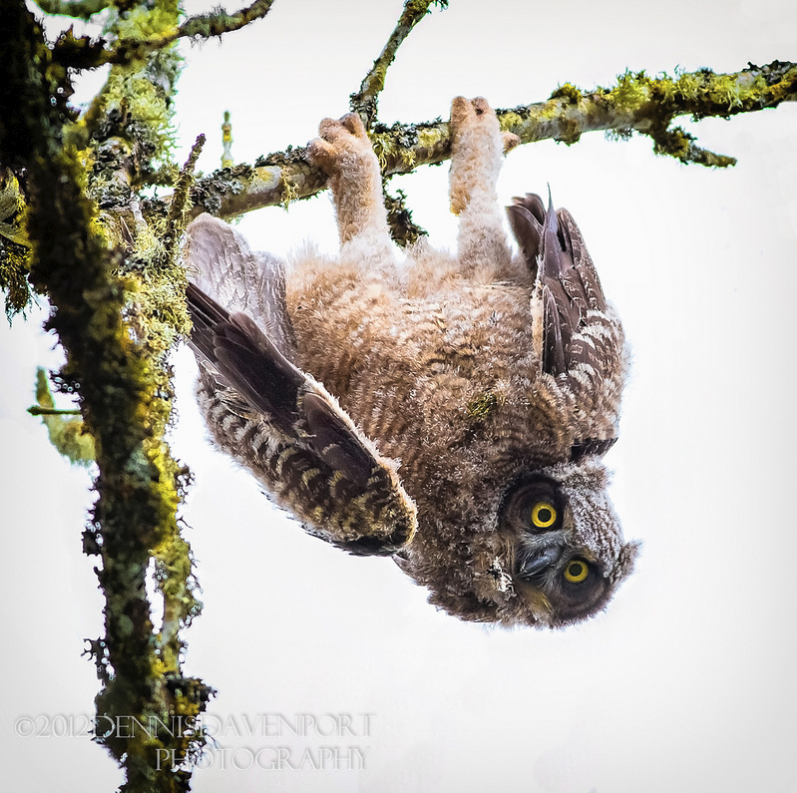Interactions

Bubo
virginanus, also known as great horned owls, have
interactions with a variety of species. Most interaction are a
part of a predator prey relationship. Great horned owls are the
top of their food chain, making them the greatest predator
(Vuilleumier 2009). In fact, to a crow, the great horned owl is
the most feared predator. Because of this, it is found often
that masses of crows vocally harass the owls as a defense
mechanism (Elphick et al. 2001). Other birds such as
red-tailed hawks, ravens, or northern harriers will physically
harass great horned owls (Rohner 2000). Bubo virginianus
are carnivorous birds that eat a variety of other animals.
Mammals that they eat can range from as small as a rat to as
large as other owls or skunks(Elphick et al.
2001). One mammal they particularly like are
snowshoe hares. The owls will typically go for the young
because adult snowshoe hares have learned to avoid predation
while the young are vulnerable (Rohner and Krebs 1996). They will also eat larvae,
insects, and even frogs (Elphick et al. 2001,
Vuilleumier 2009). Since the females are typically larger than
the males, the females tend to eat larger species or larger
individuals within a species (Longland 1989).
Bubo virginianus have
many adaptions for obtaining food for their young and
themselves. These owls are nocturnal, meaning they hunt at night
(Alderfer 2005). This hunting tactic eliminates competition for
obtaining food and keeps the food from getting stolen by other
competitors (Elphick et al. 2000). Another tactic
includes hunting in open areas; this eliminates obstacles when
hunting (Rohner and Krebs 1996). Great horned owls
are also aerial hunters that swoop in to capture their prey
(Elphick et al. 2001, Vuilleumier 2009). Since the
males are smaller, it is easier for them to maneuver and capture
their prey (Longland 1989). They have specialized toes that
rotate inward; this allows the owls to easily grab their prey
with their claw-like feet (Elphick et al. 2000). Their
young call out with a begging call; this squawk or sometimes
hiss helps the mother owls locate her fledglings so she can feed
them (Kinstler 2009). If an owl is not hunting for their young,
it is common for the owl to eat its prey right away whole; this
is another technique to eliminate the possibility of food
getting stolen. Like other owls, the indigestible materials,
including feathers, bones, and exoskeletons, are compacted into
a pellet; this pellet is later ejected out of their mouths
(Elphick et al. 2001). To learn more adaptaions of
great horned owls, go to our
adaptations page.
Another interaction Bubo
virginianus has with another species negatively affects
their health; this species are black flies. Black flies carry
and distribute avian malaria. If a great horned owl, the host,
were to be infected by flies, the fitness of the owl would be
reduced. The hosts' blood cells and hemoglobin levels would
decrease. A more obvious effect is decreased clutch size.
Luckily great horned owls have learned to avoid black flies by
specifically selecting their roosting sites. In the summer,
Bubo virginianus tend to roost lower on stumps and the
ground where black fly populations are lower than the mid
canopy. In the winter, they move to the more hidden perches a
couple meters off the ground when black fly populations overall
decrease. Even though black flies do not live at the top of the
canopy, great horned owls tend to avoid the top canopy year
round due to harassment from other birds (Rohner 2000).
The hosts' blood cells and hemoglobin levels would
decrease. A more obvious effect is decreased clutch size.
Luckily great horned owls have learned to avoid black flies by
specifically selecting their roosting sites. In the summer,
Bubo virginianus tend to roost lower on stumps and the
ground where black fly populations are lower than the mid
canopy. In the winter, they move to the more hidden perches a
couple meters off the ground when black fly populations overall
decrease. Even though black flies do not live at the top of the
canopy, great horned owls tend to avoid the top canopy year
round due to harassment from other birds (Rohner 2000).
Bubo virginianus also have
interactions that they cannot avoid. Parasitic organisms great
horned owls interact with are mites, which include a variety of
tick species such as
deer ticks. Mites are found in the owls' nests and feed off
the blood of the owl. This can cause the hosts' health to
decline and reduce reproductive success; sometimes mites even
feed on the fledglings and affect their development (Ritchison).